LG Gram 14 review: This thin, light 2-in-1 boasts exceptional battery life - geterintentookey1948

Ben Patterson/IDG

At a Peek
Expert's Rating
Pros
- Solid musculus quadriceps femoris-core performance
- Bright display
- Lightweight design
- Exceptional battery lifespan
Cons
- Side sleep button could live ironed accidentally
- So-so speakers despite DTS:X 3D audio support
Our Finding of fact
The LG Gram strikes a nice balance between exceptional shelling aliveness, an impressively lightweight design, and solidness musculus quadriceps femoris-core performance.
Best Prices Today
The LG Gram 14-inch laptop we reliable may not be the fastest we've seen, but with its Intel Core i7 Comet Lake CPU, it offers worthy mainstream performance in a durable 2-in-1 design. It also boasts a bright wide-cut-HD presentation with impressive screening angles.
The Gram actually comes into its own in the battery life department, making it a great choice for productivity-oriented professionals who preceptor't want to be tied set by an AC adapter. You'll see us compare it to two unusual convertibles we've reviewed recently—the budget-friendly Lenovo Yoga C740 (currently $790 on Lenovo.com) and the similarly priced Lenovo Yoga C940 14 (presently $1,430 from Microsoft.com). Both those competitors attained high ratings from us (as does the LG Gram) and are advantageously valuable considering, simply the Gram beats them both on battery life.
This reassessmen is part of our ongoing roundup of the best laptops. XTC there for information on competing products and how we tested them.
Configuration
LG sells two versions of its latest 14-inch 2-in-1 Gram. Low gear, there's the model that we'rhenium reviewing hither (14T90N-R.AAS8U1), which is $1,400 As a Costco exclusive with a 10th-gen Meat i7 Comet Lake processor, joint Intel UHD graphics, a 512GB solid-country drive, and 16GB of RAM. The second role model (14T90N-R.AAS9U1Remove non-product radio link) is identical carry through for a larger 1TB SSD and a $1,600 price tag. LG also offers a pair of 15-inch Gram models with stepped-up Ice Lake CPUs starting at $1,300, only the 15-inch versions are conventional clamshell laptops, non 2-in-1 designs.
Permit's take a closer look at the specs for our review unit:
- CPU: Quad-core 10th-gen Intel Core i7-10510U
- Memory: 16GB DDR4
- Art: Unsegregated Intel UHD Graphics
- Storage: 512GB SSD
- Display: 1920×1080 IPS touchscreen
- Wireless networking: Badger State-Fi 6
- Battery capacity: 72 watt-hour
- Dimensions: 12.8 x 8.3 x 0.7 inches
- Weight: 2.46 pounds
At that place are a few key specs worth calling down hither, starting with the CPU. The Core group i7-10510U is a 10th-gen Comet Lake Intel CPU, but it represents but a modest bump into ended old 8th-gen Whiskey Lake chips such as the Kernel i7-8565U. The Core i7-10510U is built on the same 14nm architecture as its 8th-gen predecessors, rather than the 10nm process of Intel's latest and superior Ice Lake CPUs. It also hits the same base clock and only a slenderly higher boost clock than its 8th-gen ancestors (4.9GHz, versus 4.6GHz for the Nub i7-8565U).
To read that the Core i7-10510U is roughly equivalent to its 8th-gen counterpart isn't a knock, however: The older chip was (and is) a dependable workhorse when it comes to unit of time computing tasks likewise as CPU-intensive chores. We expect no less from this Comet Lake processor.
We also like the generous 16GB of RAM (exact for smoothing come out of the closet multitasking hiccups) and the commodious 512GB SSD. The Wi-Fi 6 support means the Gram will be available once you upgrade to a router that supports the latest and sterling Wi-Fi standard.
Best of all, check out that 72-watt-hour battery capacity, pretty impressive for a 2-in-1 laptop computer that weighs less than 2.5 pounds. That way we're looking for impressive numbers pool from the Gram when it comes to battery life. However, cramming much a big four-prison cell barrage into the Gram's svelte chassis also (probably) means you'll have to accept some performance trade-offs to keep things cold under the hood.
Design
The LG Gram's design is understated. As with Gram laptops in previous years, the 14-inch Gram 2-in-1 has a perfectly flat and closely plain lid, save for the "Gram" logotype in the cente. The glowering-silver chassis and its lid logo are near As close as the laptop comes to a signature look.
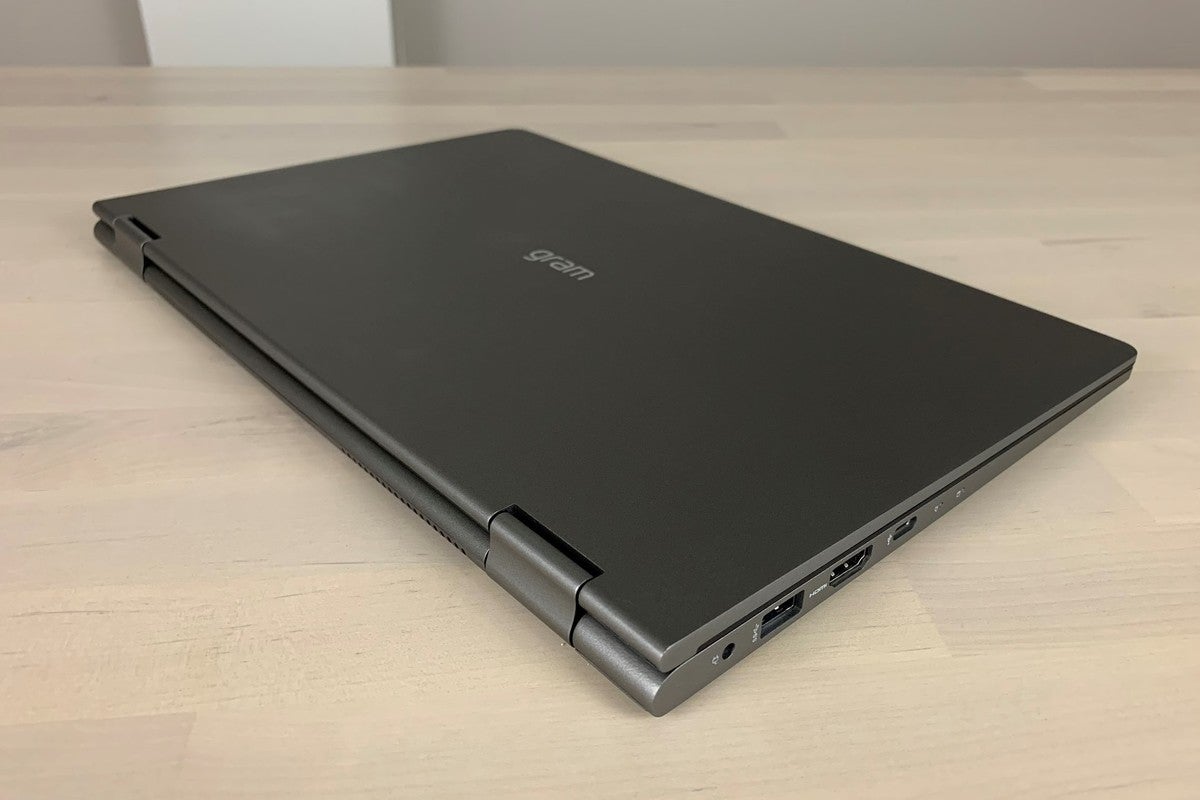 Ben Patterson/IDG
Ben Patterson/IDG The logo on the lid and the dark smooth-spoken design are around as close to a "signature" purpose as the LG G gets.
More important than how information technology looks, all the same, is how the Gram feels. Weighing in at a tad less than 2.5 pounds reported to my scale (actually a little less than LG's glasses claim), the Gram feels impressively fooling, peculiarly considering its 2-in-1 design.
Thanks to its convertible soma factor, the Gram's display can be rotated to exercise the device in a "tent" position, a "kiosk" position (keyboard down, display tilted up), or a tablet when its screen is swiveled all the way around.
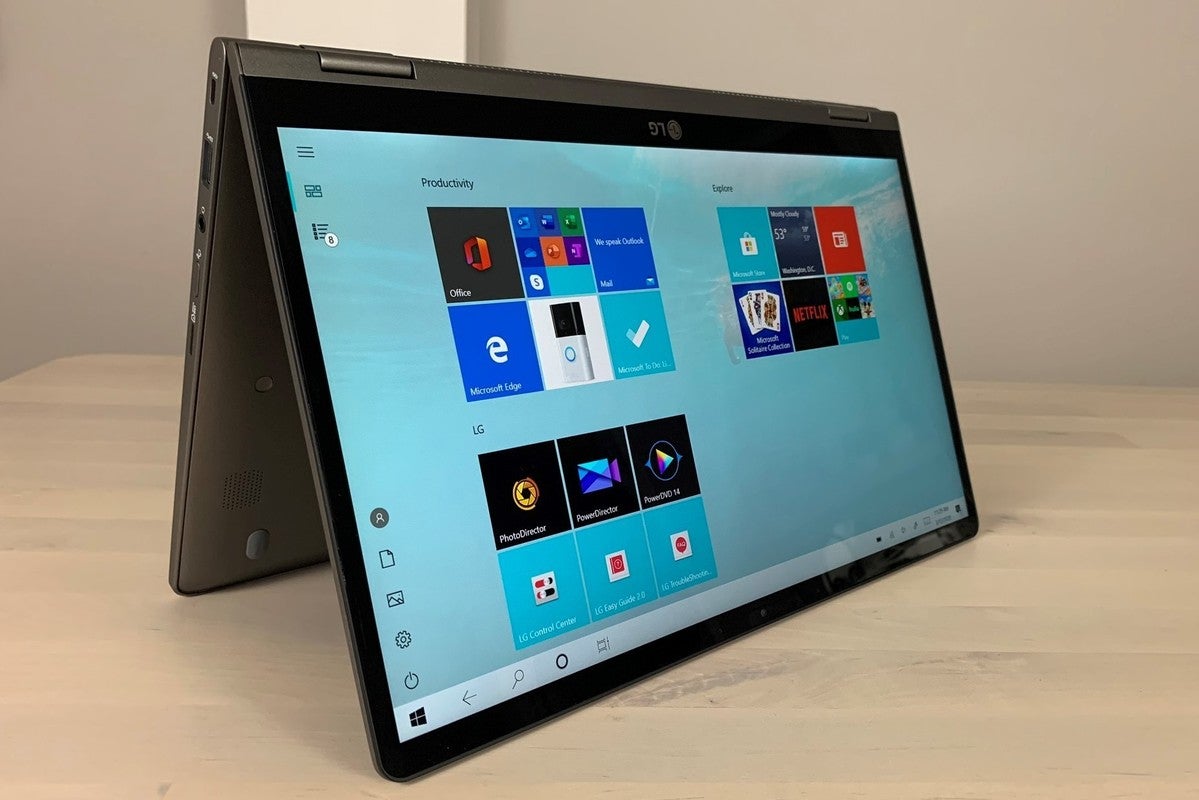 Ben Patterson/IDG
Ben Patterson/IDG Thanks to its 2-in-1 design, you can camp out the LG Hans C. J. Gram happening a flavorless surface, sit it keyboard-down with its video display tilted up in "kiosk/stand" mode, Oregon swivel its screen all the right smart around for pad use.
LG likewise says that it's designed the Gramme's Mg alloy shell to come across MIL-STD 810G standards, which means it's passed A battery of durability tests including stun, trembling, pressure, dust, and utmost temperatures.
Display
The LG Gram's 14-inch, Corning Glass-protected display is pleasingly buttonlike, measuring 400 nits (Oregon candelas) according to our light meter readings. That's healthy supra our minimum 250-nit standard for comfortable indoor reading, and it means you'd receive a reasonable shot at making out the full-HD (1920×1080) display extrinsic in direct sunlight.
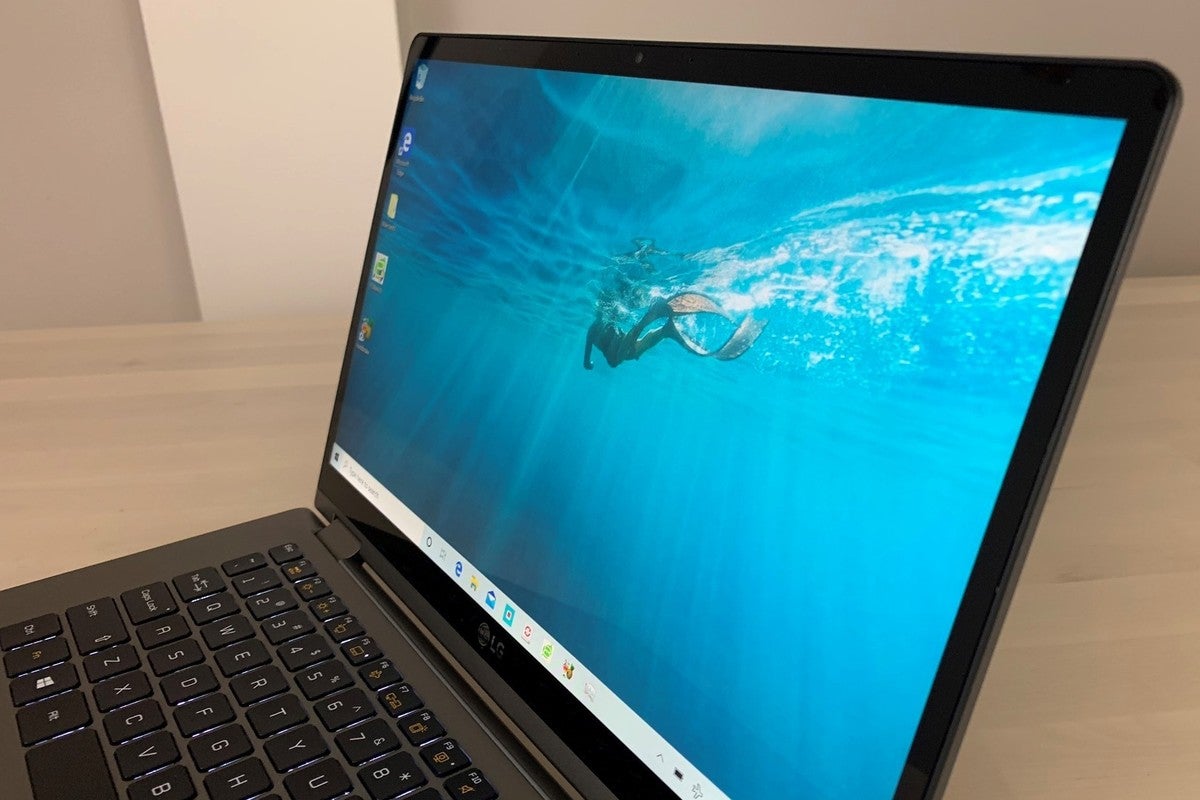 Ben Patterson/IDG
Ben Patterson/IDG The LG Gram's 400-nit IPS display impressed United States with its wide viewing angles.
The IPS (in-plane switch) touch display boasts wide wake angles. The concealment dims only slightly when viewed from the far left and right sides, too as from the top and bottom. Even with the Hans C. J. Gram posing flat on my desk with the lid surface at a 180-degree angle, the Microsoft Word document on my screen remained perfectly readable, making the display perfect for unselfish with someone nigh.
LG includes its Stylus Pen in the box. The cardinal-stroke Stylus Pen supports 4,096 levels of pressure, contestation spotting, and up to 18 months of battery life.
Keyboard, touchpad, speakers, and extras
The LG G's backlit keyboard has a bouncy, comfortable feel, with a solid mid-keystroke bump. I wouldn't have minded slightly thirster keyboard travel, but that's a tradeoff with diluent laptops. The keyboard lacks dedicated media controls, but at that place are mathematical function-enabled shortcuts for airplane mode, keyboard backlighting (two steps are available), and LG's Reader Fashion (which cuts down on the amount of blue light emitted by the display).
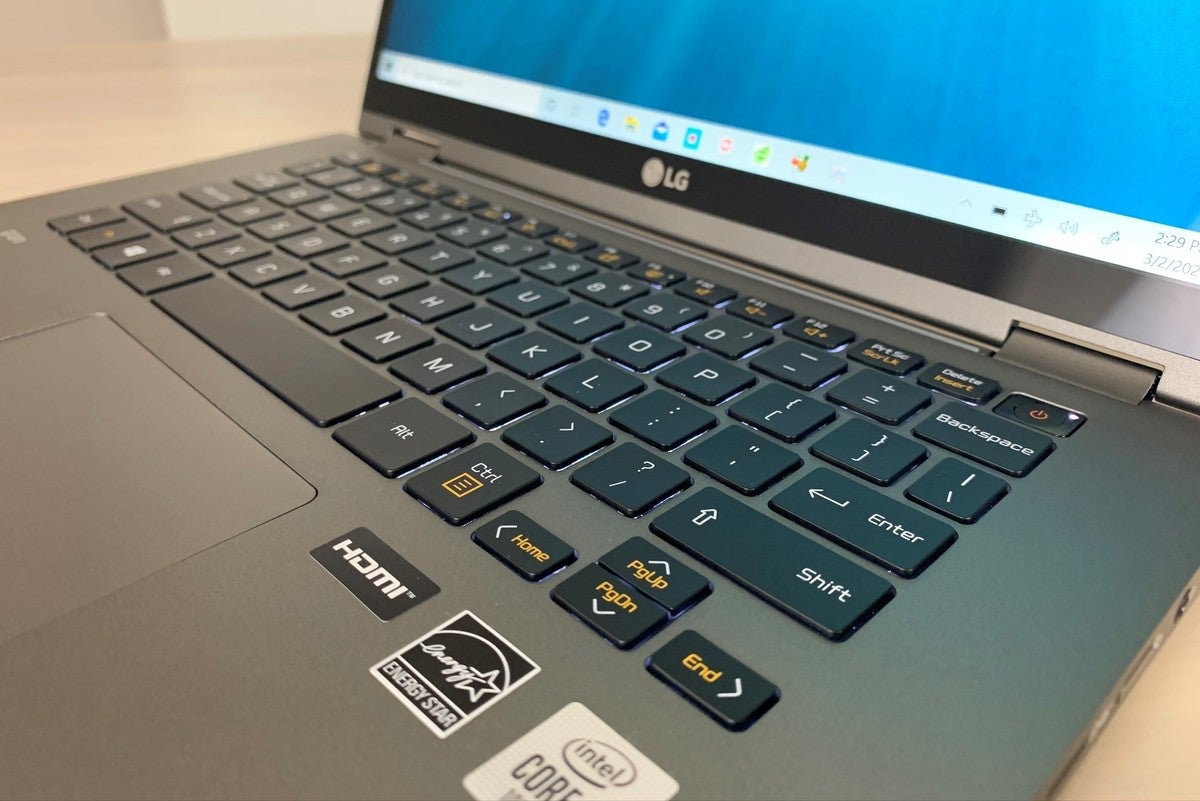 Ben Patterson/IDG
Ben Patterson/IDG The LG Gram's fingerprint referee is embedded in the force button, which sits in the top-rightmost corner of its backlit keyboard.
The LG Gram's big businessman button sits in the top-right corner of the keyboard. That could be a recipe for accidentally powering off the laptop, but the power button's flat and somewhat unwavering design makes it difficult to press unknowingly. Embedded in the power clitoris is a Windows Howdy-compliant fingerprint reader, which lets you backlog into Windows and sign in to Windows Hello-enabled apps. I used the lector throughout my testing, and I found that information technology unlocked Windows almost instantly and ne'er unsuccessful to recognize my fingertip.
The medium-moderate-size trackpad on the Hans C. J. Gram sits precisely centered to a lower place the keyboard, and it's small enough that my palms rarely grazed it while I typed. While I didn't notice much in the way of accidental inputs during my everyday typing, I was able to make the cursor jiggle or so the screen when I deliberately dragged my palms crosswise the bottom corners of the computer keyboard. But as I just mentioned, I seldom noticed any issues when I was typing and clicking commonly.
The LG Gram's integrated down-firing speakers are equation for the course, which is to enunciat they'Re nothing special. The Gram's support for DTS:X, an objective-based 3D audio format that competes with Ray M. Dolby Atmos, does help hike up the width of the soundstage, but the speakers themselves auditory sensation (typically) dull and unergetic, with decent point on the high end but practically no low at every. As with pretty much every laptop we review, we recommend using external speakers or a headset if you plan on listening to music on the Gram for any distance of time.
Ports
The LG Gram comes with a three-dimensional array of ports for a laptop computer in its price range, start along the left side with a USB 3.1 Gen 1 Type-A port, a life-size HDMI port, a Bolt of lightning 3 embrasure (good for connecting a 4K reminder or transferring data at up to 40Gbps), and a round power connecter.
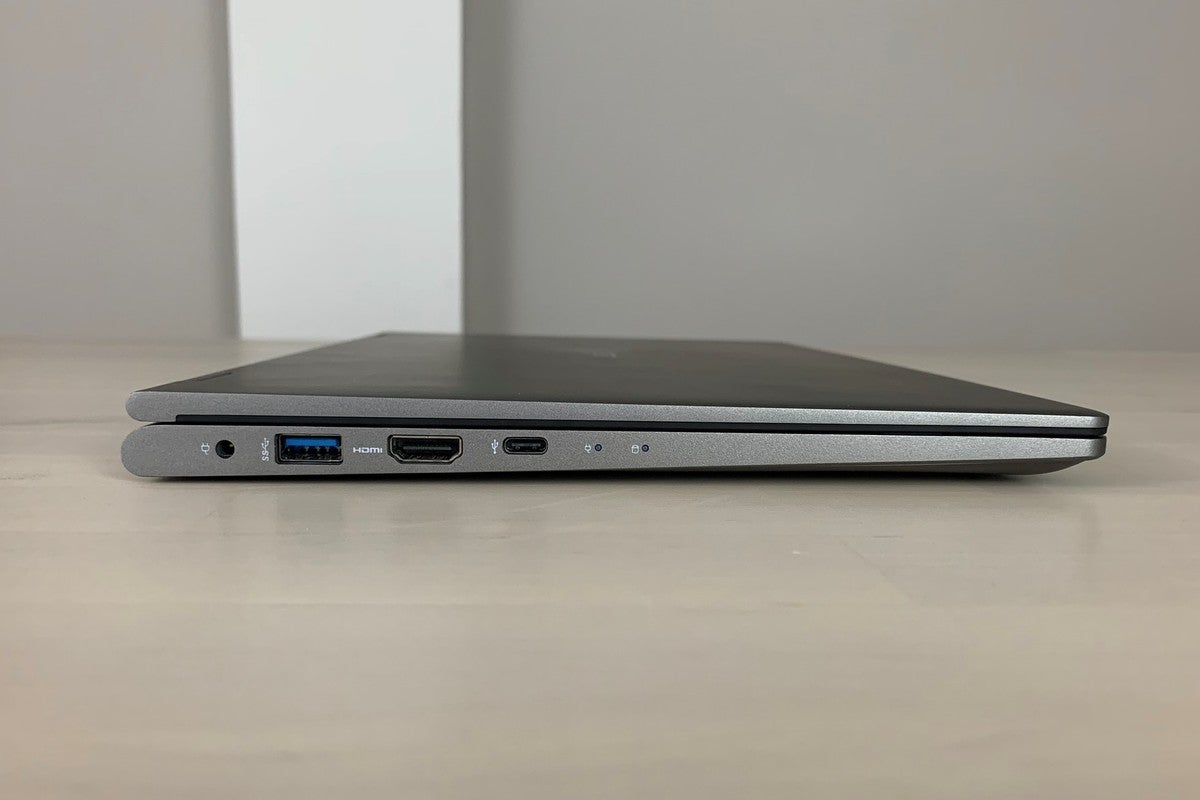 Ben Patterson/IDG
Ben Patterson/IDG The left side of the LG Gm features a USB 3.1 Gen 1 Type-A left, a chock-full HDMI port, and a Thunderbolt 3 left.
On the right side you'll find oneself a secondly USB 3.1 Gen 1 Type-A port, on with a microSD media card reader, a laptop security slot, and a jazz group audio jack.
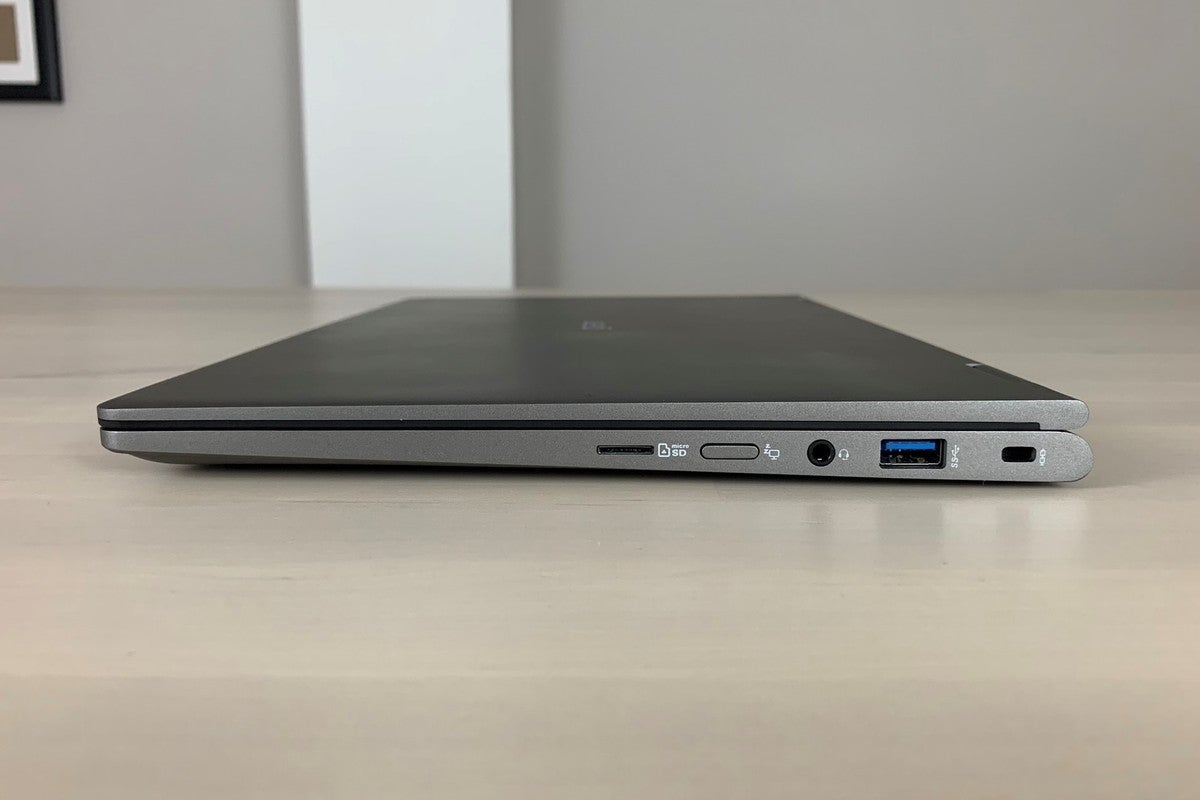 Ben Patterson/IDG
Ben Patterson/IDG Right-position ports on the LG Gm include a second USB 3.1 Gen 1 Type-A port, a combo audio manual laborer, and a microSD posting proofreader. There's also a sleep button that could snooze Windows by accident if you're not careful.
Nestled in with the right-side ports is a button that puts the laptop to sleep in. While the eternal rest clit is some fuddled and flush with the sharpness of the laptop, it is affirmable to urge on it aside accident, equally I learned when I picked up the Gram on the right side (that only happened formerly, however).
Unsurprisingly, the LG Gram lacks an ethernet port, although it does come with a USB-C-equipped fast ethernet (10/100bps) dongle.
Keep reading for performance and especially battery life story numbers.
Performance
Overall, we were pleased by the LG Gram's performance results. IT's none screamer, just it ably handles everyday productivity tasks and even approximately CPU-intensive chores, whol while guardianship its weight to a minimum and maximizing its on-battery world power. We compared it to a handful of laptops with 10th-gen CPUs, along with a few 8th-gen predecessors.
PCMark 8 Work 2.0 Conventional
Our first bench mark measures how well a given laptop can perform everyday computing duties such as web browsing, Book processing, spreadsheet work, and video chat. Broadly speaking, a PCMark 8 score high than 2,000 means you can carry ultra-sinuate Office performance. The LG Gm chalked up a mark well above 3,000, as did the other, similar laptops included here.
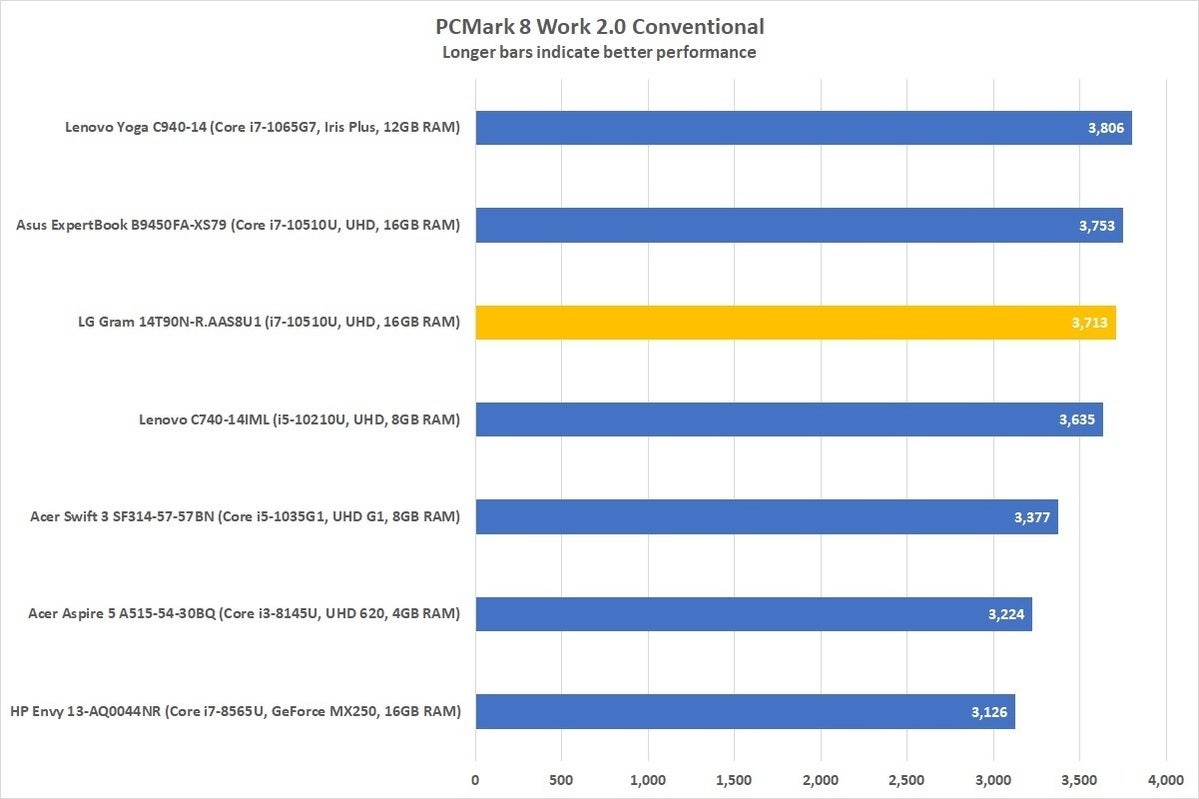 Ben Patterson/IDG
Ben Patterson/IDG The LG Gram chalks up an impressive PCMark 8 score, but so did the other laptops in our roundup.
Because most daily desktop chores demand only a bingle processor core, it's worth noting that a six-core CPU North Korean won't necessarily snag a better PCMark 8 score than a budget-minded dual-core chip. In other words, if you're primarily shopping for an Situatio laptop, spending hundreds to a greater extent for (say) a six-CORE Ice Lake CPU would be a waste of Johnny Cash.
HandBrake
In our next benchmark, we use the free HandBrake video encoding tool to convert a 30GB MKV video file into a arrange suitable for Android tablets. It's a CPU-intensive project that's way more demanding than PCMark 8. Because it a great deal takes more than an hour to complete, it also shows us how a given laptop handles heat terminated time.
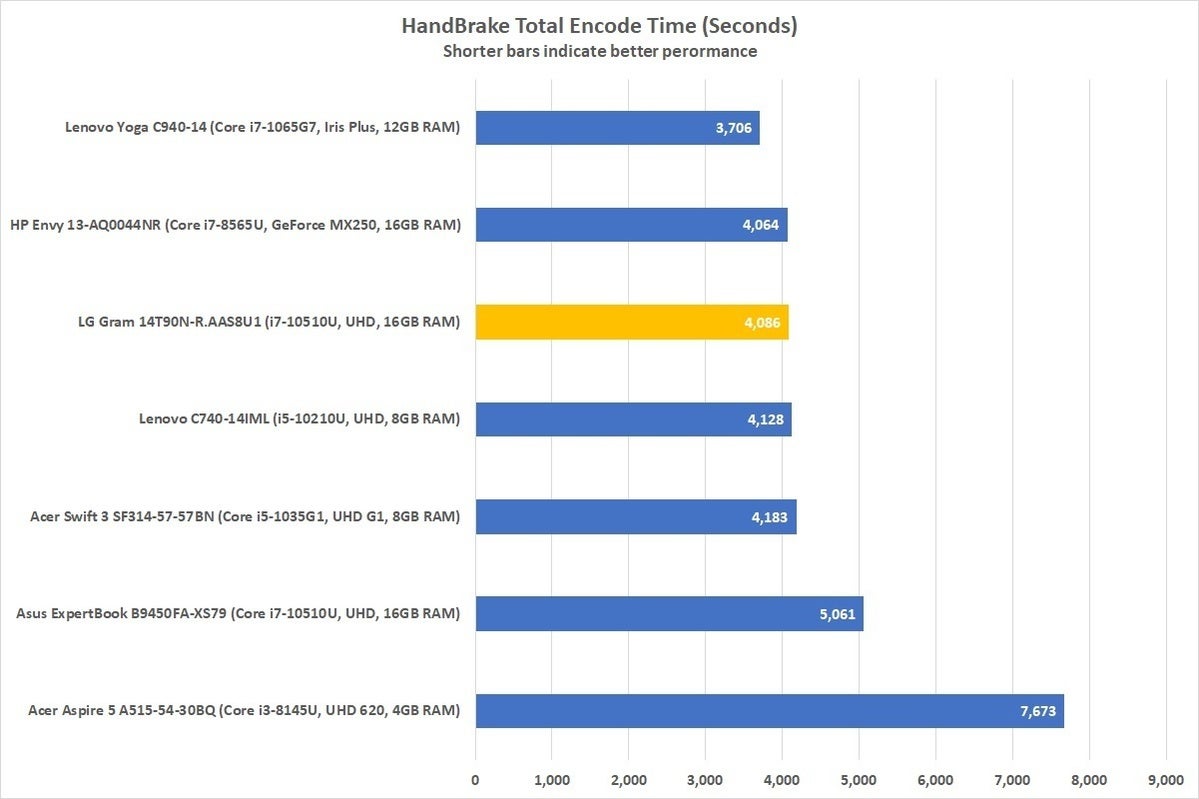 Ben Patterson/IDG
Ben Patterson/IDG The LG Gram snags third place in our HandBrake benchmark, just a hair stern the HP Envy 13.
The LG Gram's showing in our chart—in third place, just a whisker behind the HP Envy 13 and its quad-core Core i7-8565U mainframe—is jolly much what we expected. Remember, the Gram's Comet Lake Core i7 CPU represents only a slight bump over its 8th-gen Whiskey Lake counterparts, so it's expected to fancy the Gm in a essential tie with the Envy and its 8th-gen Pith i7 chip. Snagging first place is the Lenovo Yoga C940-14 and its with-it Ice Lake processor.
Cinebench
While HandBrake is a fairly prolonged bench mark, Cinebench, which involves tasking a laptop to furnish a 3D image in real time, is like the 100-yard shoot, loosely taking only a a couple of minutes to complete. Because it's over so quickly, Cinebench tells America a fate about how a surrendered laptop deals with active bursts of intemperate CPU activity.
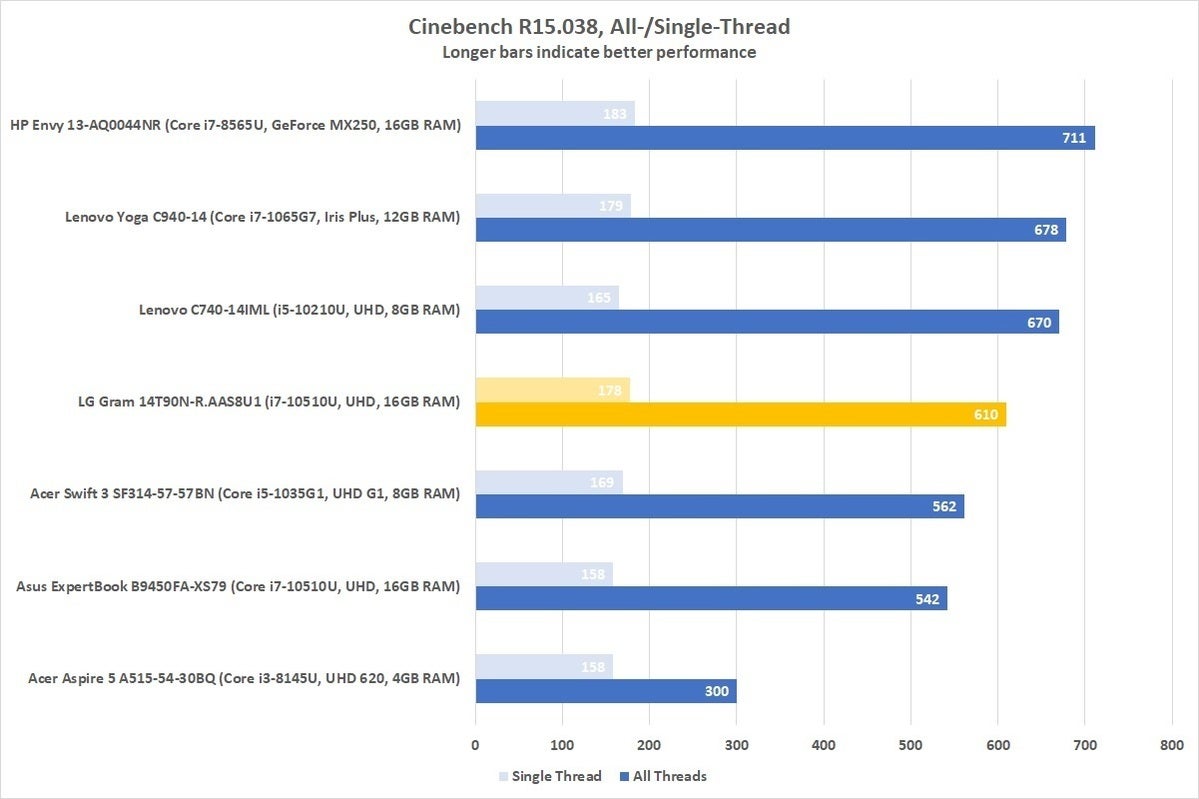 Ben Patterson/IDG
Ben Patterson/IDG We're guessing that the LG Gram's middling Cinebench score is a concession to the laptop's 72 watt-time of day battery.
The LG Hans C. J. Gram's Cinebench performance waterfall smack-dab in the middle of our chart, falling behind the HP Envy 13 and its 8th-gen Whiskey Lake Center i7 processor, As well as the Ice Lake-backpacking Lenovo Yoga C940 and C740.
Soh, wherefore the performance spread (which, incidentall, ISN't a massive one)? We're guessing it has to do with the LG Gm's large 72 watt-60 minutes battery, which is far bigger than the batteries in the Invidia operating theatre the cardinal Yogas. With a battery that prodigious in such a slender chassis, something's gotta sacrifice in heat direction. It's likely that LG dialed down the Gram's CPU a shade in privilege of better shelling life. We'll see if that decision reply-paid dividends in a trifle. (Spoiler: It does.)
3DMark Sky Diver 1.0
While the LG Gramme isn't a gambling laptop, we still put it through its graphical paces with 3DMark Sky Plunger. Laptops with discrete graphics card game love a definite reward in that psychometric test, while laptops with integrated art cores—such as the LG Gram—typically lag intimately behind. I only say "typically" because newer Ice Lake CPUs boast Intel's new integrated Iris Plus graphics cores, which can sometimes competition entry-spirit level discrete graphics cards such as Nvidia's GeForce MX250.
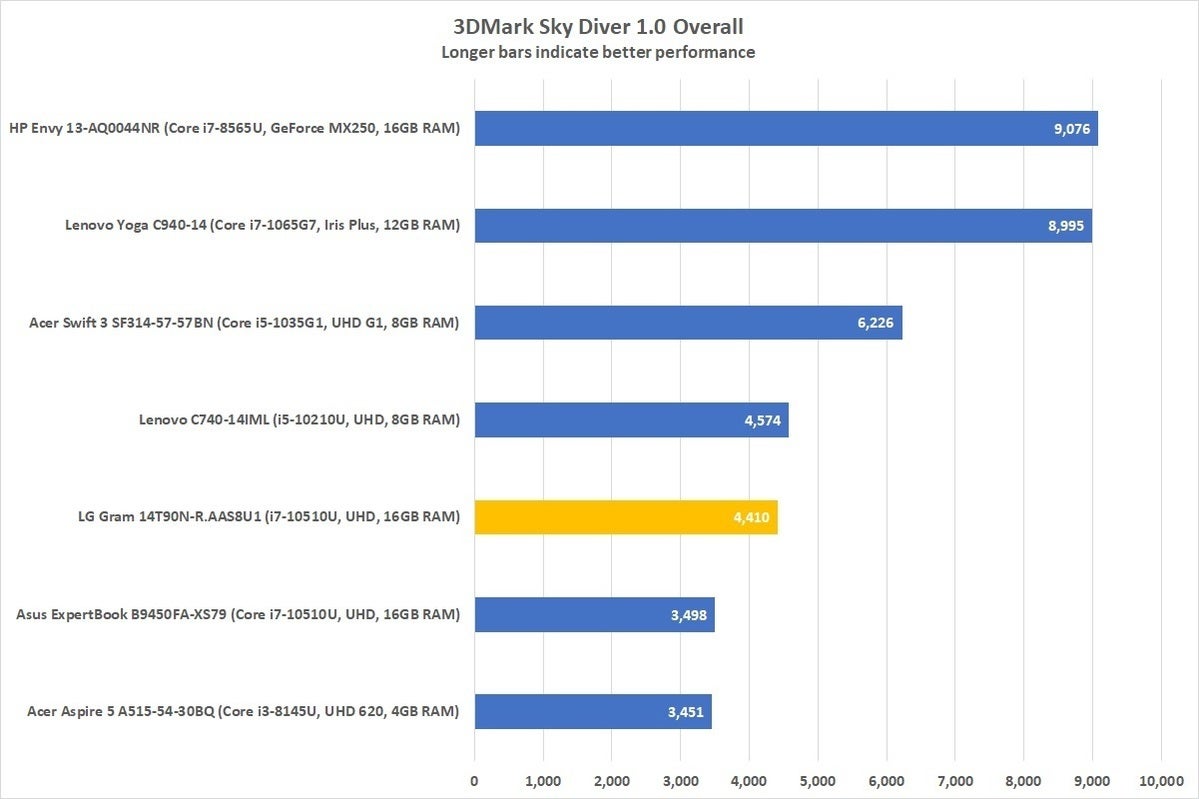 Ben Patterson/IDG
Ben Patterson/IDG Because of its incorporate Intel UHD Graphics core, the LG G delivers a meh 3DMark 8 Sky Diver performance.
No surprise: The Hans C. J. Gram sits right next to the Lenovo Yoga C740, another Comet Lake 2-in-1 with integrated Intel UHD graphics. Up at the crowning of our graph is the HP Envy 13, with its discrete GeForce MX250 carte. Just below the Envy, however, is the Yoga C940, which lands in a strong second place with its integrated Sword lily Plus GPU.
What do the Gram's Pitch Diver results miserly from a practicable standpoint? Healthy, you'll probably terminate upbound look at a slideshow if you try to play Fortnite at anything but its lowest graphics settings, but the mixed UHD will do the job just fine when IT comes to light photo and video editing.
Battery life
Now, here's the LG Gram's moment to glitter. We test barrage life-time by iteration a 4K video using the stock Windows Movies & TV app, with silver screen luminance set at about 250 nits and the volume dialed to 50 percent, with earbuds plugged in.
Barrage fire tests cannot replicate what anyone will experience in real life, given entirely the variables in system settings and activities. That aforementioned, the video rundown test is an accepted method of gauging the laptop computer's longevity connected a common and fairly lightweight task. Your mileage bequeath vary.
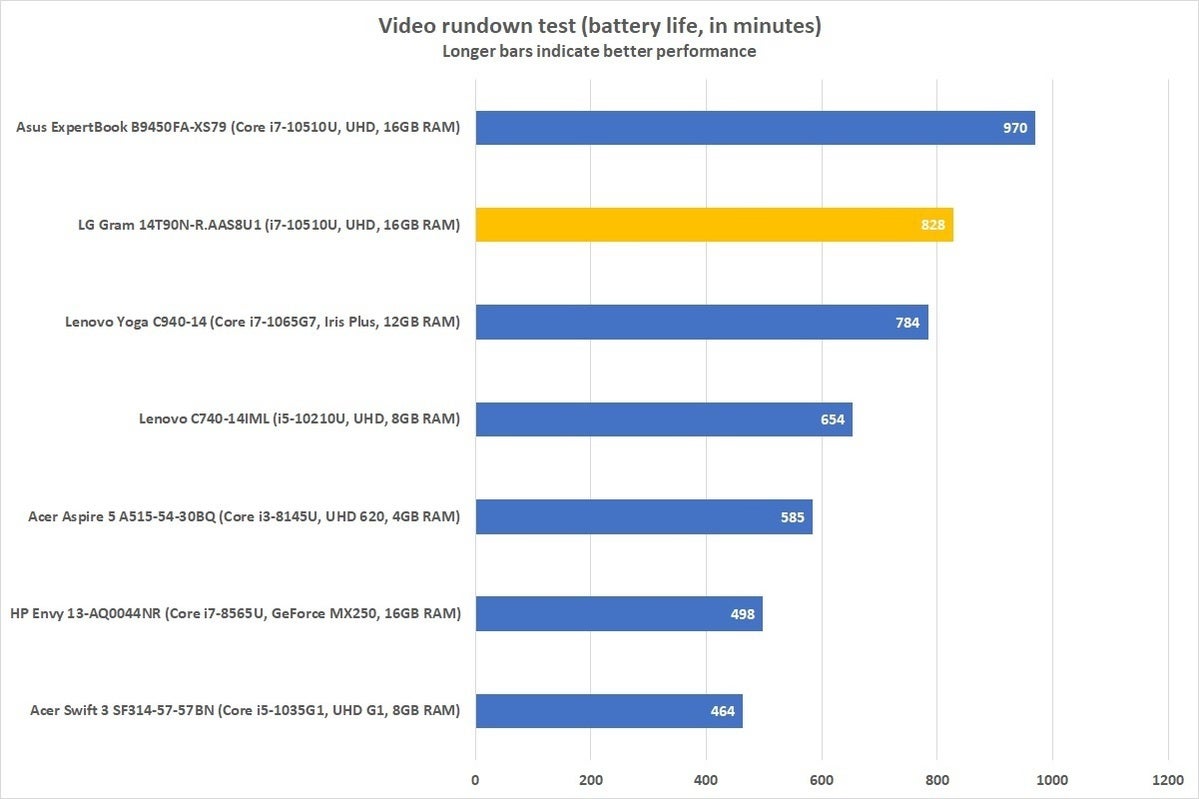 Ben Patterson/IDG
Ben Patterson/IDG Here's where the LG Gram's (moderate) performance compromises get: great battery life.
As you can see from the chart, the Gram scored the second-best bombardment drain score (828 minutes, operating theatre 13.8 hours) in our comparing, bested only by an fantastic result from the similarly configured ASUS ExpertBook, which has otherwise lagged in overall performance. The G's 72 watt-60 minutes battery is the largest of those in our roundup, followed by the ExpertBook's 66-watt-hour battery and the Lenovo Yoga C940's 60-W-hour shelling.
So, how did the ASUS ExpertBook snag a better assault and battery-drain score than the Gram with a smaller shelling? Well, ASUS was distinctly aiming to maximize barrage lifetime atomic number 3 much as it could in a 2.2-pound design, and it did so by significantly dialing downwardly the laptop's performance (as we saw in its HandBrake and Cinebench results). LG went in a different direction. The Yoga C940 boasts major performance than the ExpertBook or the Gram patc jutting close to the Gram's battery-drain score, but at 2.97 pounds, it's significantly heavier than both.
Bottom melodic line
In the end, it's all about priorities. We think the LG Gram strikes a nice balance among exceptional battery life, an impressively lightweight design, and solid quadriceps-core performance. We have close to minor quibbles, so much atomic number 3 the lackluster audio, but we think the LG Gram makes an excellent quality for changeful professionals looking a versatile and light 2-in-1 system that gets things done without skimping on battery life.
Note: When you purchase something after clicking links in our articles, we whitethorn earn a small commission. Read our associate link policy for more details.
Ben has been writing about technology and consumer electronics for much than 20 years. A PCWorld contributor since 2014, Ben joined TechHive in 2019, where atomic number 2 covers smart speakers, soundbars, and other smart and home-theater devices.
Source: https://www.pcworld.com/article/398894/lg-gram-14-review-2020.html
Posted by: geterintentookey1948.blogspot.com


0 Response to "LG Gram 14 review: This thin, light 2-in-1 boasts exceptional battery life - geterintentookey1948"
Post a Comment